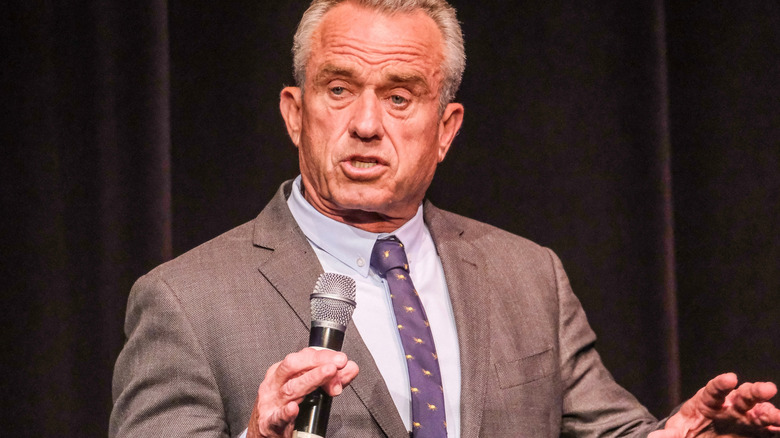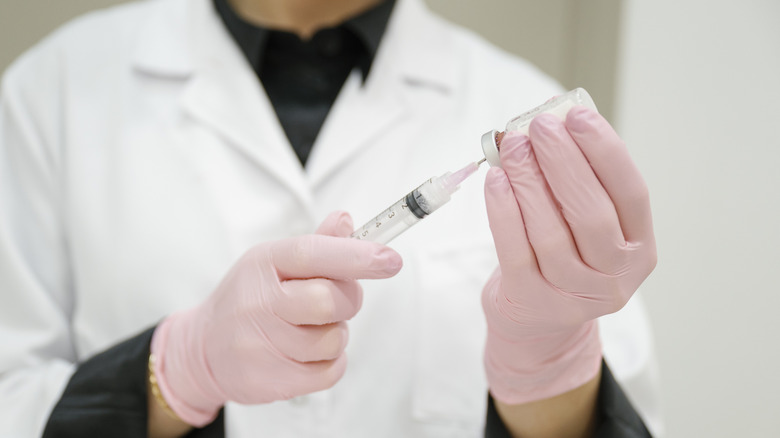The Medical Reason That Explains Robert F. Kennedy Jr.'s Voice
Many public figures are known for their unique vocal characteristics. For instance, former U.S. President Barack Obama has been praised for his smooth, calm cadence. And Yeardley Smith — the talented voiceover artist behind Lisa Simpson — wouldn't be herself without a bit of a nasal vocal quality. Yet the vocal trait that stands out for Robert F. Kennedy Jr. isn't a natural phenomenon; it's the result of a medical condition he's had for several decades. (Read about what causes your voice to change as you age).
Kennedy has circulated in the public eye since birth due to his family's social and political connections. Nonetheless, it wasn't until he ran for the presidency in 2023 that more people around the nation became familiar with him — and with the way that he sounded when he was giving speeches around the country. Specifically, many audience members noticed that when he spoke, his voice vibrated with a distinctive raspiness.
What is the cause of Robert F. Kennedy Jr.'s vocal condition?
Though it's not unusual for people's voices to become raspy or hard to control after multiple speeches, Kennedy's vocal quivering doesn't let up. That's because his raspiness isn't from overuse. (Here's what really happens when you lose your voice.) It's the result of a condition called spasmodic dysphonia.
Spasmodic dysphonia is neurological and affects around 50,000 North Americans. This condition leads to muscular spasms in and around the larynx and esophagus. Consequently, a speaker who has it, like Kennedy, may have trouble with voice control and struggle to speak without incurring a gravelly hoarseness or other unusual voice characteristic. The exact signs will vary depending on the type of spasmodic dysphonia a person has. There are three varieties of the condition: Adductor spasmodic dysphonia, abductor spasmodic dysphonia, and mixed spasmodic dysphonia.
Adductor spasmodic dysphonia is the most common among the three. During spasmodic episodes, muscles in the throat suddenly tighten, causing a speaker's words to sound strained. Interestingly, individuals with adductor spasmodic dysphonia don't experience muscular contractions when they sing, laugh, or speak in a whispered tone. Meanwhile, in cases of abductor spasmodic dysphonia, instead of tightening, the throat muscles relax to an open position. This makes it hard for a speaker to be understood because the vocal cords don't resonate. The last kind, mixed spasmodic dysphonia, is the rarest: Speakers who have this kind of condition tend to experience symptoms of both adductor and abductor spasmodic dysphonia.
Treatment options for spasmodic dysphonia
Two people with spasmodic dysphonia may present with very different signs. For example, some people with spasmodic dysphonia have trouble being heard or understood due to breathiness. In other situations, people may find that their voice can be heard but quivers as if they're ready to break into tears. Alternatively, some sufferers' speech may be interrupted by crackles and "strangle" sounds as they struggle to produce controlled intonations.
Though spasmodic dysphonia isn't life-threatening, it can be frustrating and embarrassing — as well as quite noticeable, especially for those who speak for a living. Fortunately, treatments exist that can help ease the disease's hallmark symptoms, including Botox injections. Botox tames the intensity of neurological misfiring that leads to vocal issues for those who have the disease. (Here are other unexpected conditions that can be treated with Botox.)
Voice therapy is another common spasmodic dysphonia treatment and can co-occur with Botox injections. New technologies may also provide tools to make individuals easier to understand.
Botox, but not relief, for Kennedy
Kennedy has tried at least one treatment to quell his symptoms: A 2022 NPR article quoted him as saying that he had received Botox injections to ease the tremble in his voice. However, Kennedy admitted in a 2024 LA Times article that he's not pleased with how he sounds.
In the article, Kennedy was quoted as saying that he "feels sorry" for his audiences. He qualified his self-deprecating comments, though: "My voice doesn't really get tired. It just sounds terrible. But the injury is neurological, so actually the more I use the voice the stronger it tends to get."
As of 2025, Kennedy still battles with the symptoms of spasmodic dysphonia that he's had since he was 42, according to CNN. But he hasn't allowed his condition to keep him from making speeches in his public role as the U.S. Secretary of Health and Human Services.
Unusual but not unheard of among popular figures
Though spasmodic dysphonia isn't a common medical occurrence, it has happened to other people who live in the public spotlight. For example, actress Selma Blair opened up in a 2019 Good Morning America interview about having the condition. Blair explained that her spasmodic dysphonia was directly related to her then-recent multiple sclerosis (MS) diagnosis. She remained positive, though, and appreciated that her position as a well-known performer allowed her to bring awareness to her aggressive MS and its unexpected neurological side effects.
Journalist Diane Rehm has also been candid about her spasmodic dysphonia. During a 2016 interview for The NIH Catalyst, she outlined her years-long journey to get a diagnosis for what she felt was just her voice "clamping" and "clutching." It wasn't until she was referred to a neurologist and an otolaryngologist that she found out why she was having difficulties. At that point, she began Botox treatments. (Interestingly, Rehm talked about spasmodic dysphonia with Kennedy on The Diane Rehm Show in the early 2000s.)
Signs that may help with early diagnosis
You shouldn't worry that you might have spasmodic dysphonia every time your voice cracks or loses strength. Those aren't abnormal occasional occurrences. On the other hand, if you notice that you're having trouble speaking on a regular basis (and if it's a new phenomenon for you), consider contacting a doctor.
Be especially vigilant about getting a provider's advice if you experience a shaky voice and also have some of the risk factors that are associated with spasmodic dysphonia. According to a 2002 study in The Laryngoscope, a few of those factors may include being a biological female, suffering from "writer's cramp," and having occasional tremors. A 2012 study in The Laryngoscope added exposure to throat and sinus illnesses, prior diagnosis of mumps or measles, and family history of ocular disorders or tremors to the list. However, it acknowledged that there is unlikely to be one predictor of whether or not someone will have spasmodic dysphonia.






